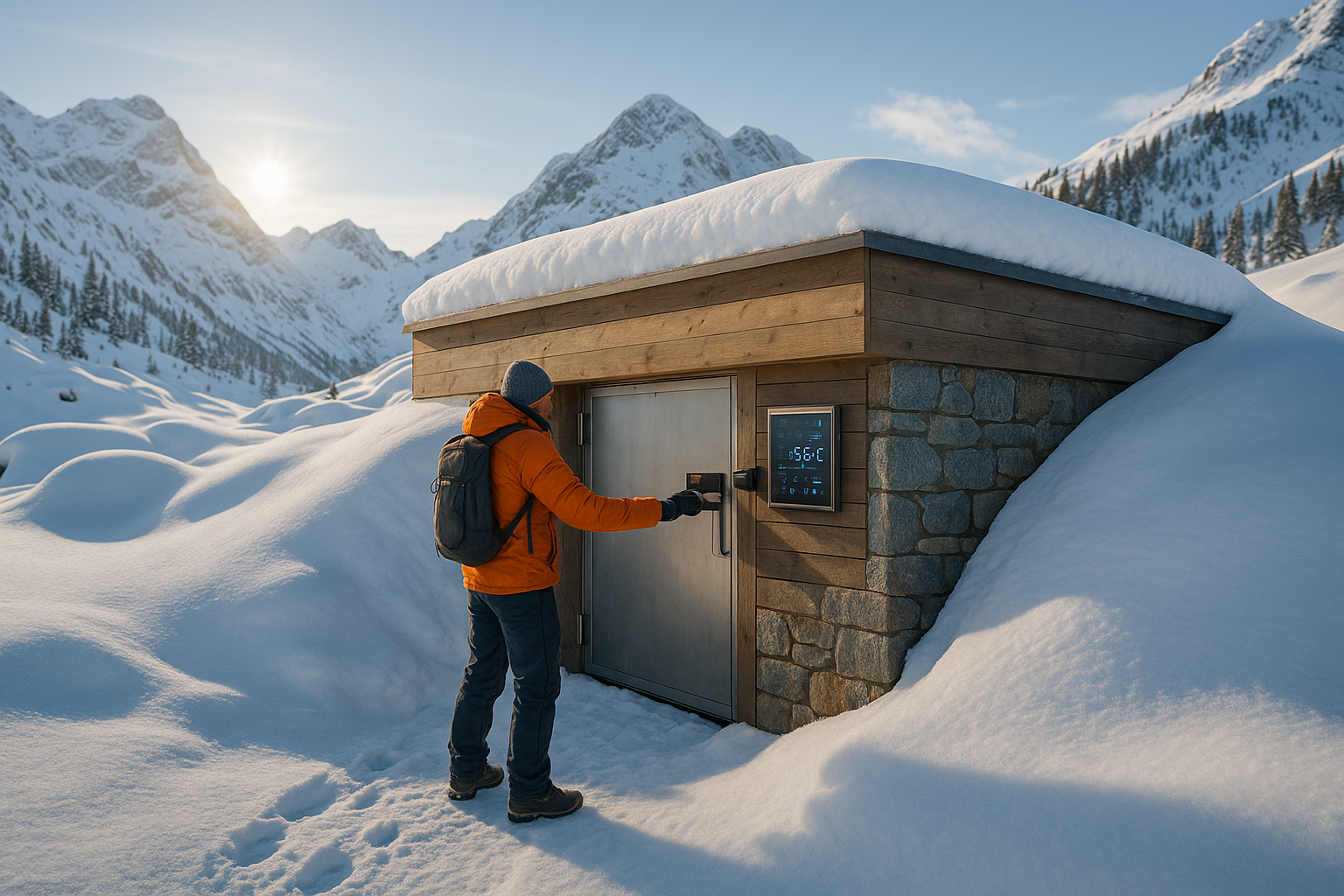In the intricate tapestry of human history, the preservation of perishable goods has played a pivotal role in shaping civilizations, influencing trade, and advancing technology. Imagine, for a moment, the bustling streets of ancient Rome or the thriving markets of the Silk Road. These vibrant centers of commerce were not just hubs of cultural exchange but also epicenters of an evolving understanding of how to maintain the integrity of goods across vast distances and fluctuating climates. At the heart of this evolution lies the concept of the “cold chain”—a complex system designed to ensure that temperature-sensitive products are kept within optimal conditions from production to consumption. 🌍❄️
As we embark on a journey through time, this article delves deep into the annals of history to explore the origins and advancements of cold chain logistics. From the rudimentary methods of ancient ice harvesting to the sophisticated, technology-driven solutions of today, understanding the historical context of cold chain development offers invaluable insights into modern preservation strategies. We’ll explore key milestones in cold chain evolution, uncovering the ingenious methods employed by various cultures to overcome environmental challenges and sustain their communities. As we trace the lineage of these practices, we will also address the inevitable challenges and setbacks that shaped the current landscape of temperature-controlled logistics.
Throughout this exploration, we will spotlight the pivotal innovations and technological breakthroughs that have defined cold chain progress. We’ll examine how these advancements not only transformed food preservation but also revolutionized industries like pharmaceuticals and agriculture. Furthermore, this article will offer a glimpse into the future of cold chain logistics, considering the role of emerging technologies such as blockchain and IoT in enhancing efficiency and transparency. By unlocking the past, we aim to illuminate the path forward, equipping industry professionals with the knowledge and inspiration needed to craft optimal preservation strategies for a rapidly changing world. Prepare to embark on a fascinating journey through time, where the lessons of history serve as a guiding light for the future of cold chain logistics. 🌟
Introduction to Historical Cold Chain Analysis
The concept of cold chain preservation has been pivotal in various industries, particularly in food, pharmaceuticals, and even some industrial applications. As we delve into the intricacies of historical cold chain analysis, we uncover valuable insights that inform modern preservation strategies. This exploration highlights the development of techniques over time and how they have been instrumental in ensuring optimal product quality and safety.
Understanding the past methodologies and technologies employed in cold chain logistics not only provides a blueprint for current practices but also sets the stage for future innovations. From the rudimentary practices of ancient civilizations to the sophisticated technologies of the present day, the evolution of cold chain logistics is a testament to human ingenuity and the relentless pursuit of perfection in product preservation.
Early Practices in Cold Chain Logistics
The origins of cold chain logistics can be traced back to ancient times when civilizations discovered the benefits of natural cooling techniques. Before the advent of modern refrigeration, ice and snow were the primary means of preserving perishables. Ancient Egyptians, Greeks, and Romans utilized ice harvested during winter months to store food and drinks, a practice that laid the groundwork for more advanced preservation methods. These early methods, though primitive by today’s standards, demonstrated a clear understanding of the need to control temperature to prolong the freshness and safety of consumables.
One of the earliest examples of cold storage is the use of ice houses, structures built to store ice throughout the year. These were prevalent in several ancient cultures, serving as a precursor to the modern refrigerator. The ice was often harvested from lakes and ponds during winter and stored in underground chambers insulated with straw or sawdust. The ingenuity of these methods is evident in their efficiency, as they managed to keep ice intact for extended periods even during warmer seasons.
| Civilization | Method | Materials Used |
|---|---|---|
| Ancient Egyptians | Ice Harvesting | Natural ice, Straw |
| Greeks | Ice Storage | Ice, Clay pots |
| Romans | Ice Houses | Ice, Sawdust, Stone |
As these early practices evolved, so did the understanding of the mechanisms at play. The development of thermal insulation materials and techniques marked significant progress, enabling the more efficient management of temperature-sensitive goods. This evolution reflects a continuous quest for better, more reliable preservation methods—a trend that continues to drive innovations in the field today.
Technological Advancements and Breakthroughs
The industrial revolution marked a turning point in cold chain logistics, introducing a wave of technological advancements that revolutionized the way temperature-sensitive products were preserved and transported. The invention of the mechanical refrigerator in the 19th century was a groundbreaking development that set the stage for modern refrigeration systems. This innovation allowed for the controlled cooling of products, ensuring consistent and reliable preservation across various industries.
Refrigerated transport, or “reefer” units, emerged as a critical component of the cold chain, enabling the long-distance shipment of perishable goods. These units utilized mechanical refrigeration systems to maintain specified temperatures, significantly reducing spoilage and extending the shelf life of products. The introduction of refrigerated transport was particularly transformative for the food and pharmaceutical industries, facilitating global trade and the distribution of temperature-sensitive medications.
As technology continued to advance, so did the precision and efficiency of cold chain systems. The development of sophisticated sensors and monitoring devices enabled real-time tracking and management of temperature conditions, ensuring optimal preservation throughout the supply chain. These technologies provided unprecedented visibility into the cold chain process, allowing for proactive interventions and improved quality control.
Modern Innovations in Cold Chain Management
Today’s cold chain management systems are characterized by a high degree of automation and integration, leveraging cutting-edge technologies to enhance efficiency and reliability. Internet of Things (IoT) devices, for example, have become integral to modern cold chain operations, providing real-time data on temperature, humidity, and other critical parameters. This data-driven approach enables more informed decision-making, reducing the risk of spoilage and ensuring compliance with regulatory standards.
Moreover, the rise of blockchain technology has introduced new possibilities for transparency and traceability in the cold chain. By creating immutable records of each transaction and condition change, blockchain enhances accountability and trust throughout the supply chain, offering a powerful tool for quality assurance and risk management.
For a deeper understanding of these advancements, watch the following video on the evolution of cold chain technologies: “The Evolution of Cold Chain Technologies” – Cold Chain Channel. This video provides an insightful overview of the key innovations driving the industry forward.
The Role of Data and Analytics in Cold Chain Optimization
In the current era, data and analytics play a pivotal role in the optimization of cold chain logistics. The vast amount of data generated by modern monitoring devices provides valuable insights into the efficiency and effectiveness of preservation strategies. By analyzing this data, companies can identify patterns and trends that inform improvements in their cold chain operations.
Predictive analytics, for instance, allows businesses to anticipate potential issues and take preemptive actions to mitigate risks. This proactive approach not only enhances product quality but also reduces costs associated with spoilage and waste. Furthermore, advanced analytics tools enable the identification of inefficiencies within the supply chain, paving the way for process improvements and cost savings.
As the importance of data in cold chain management continues to grow, so does the need for skilled professionals who can interpret and leverage this information effectively. The integration of artificial intelligence and machine learning technologies into cold chain systems further underscores the critical role of data in driving innovation and excellence in preservation strategies.
Challenges and Future Directions
Despite the significant advancements in cold chain logistics, several challenges remain. Ensuring the integrity of temperature-sensitive products throughout the supply chain requires robust systems and processes that can adapt to changing conditions. Environmental factors, such as climate change and energy consumption, also pose challenges to cold chain sustainability, necessitating the development of eco-friendly solutions.
As the industry continues to evolve, the focus on sustainability and energy efficiency will likely drive future innovations. The exploration of alternative refrigeration technologies and renewable energy sources is already underway, promising to enhance the sustainability of cold chain operations.
For those interested in exploring the latest trends and challenges in cold chain logistics, the following video provides an in-depth look at current industry dynamics: “Future Trends in Cold Chain Logistics” – Logistics Insight Channel. This resource offers valuable perspectives on the future of cold chain management.
By continuously learning from historical practices and embracing modern innovations, the cold chain industry is well-positioned to meet the growing demands of global supply chains, ensuring the safe and efficient delivery of temperature-sensitive products worldwide. 🌍

Conclusion
Unlocking the past through the lens of historical cold chain analysis has unveiled a multitude of insights into the preservation strategies that have shaped industries and societies. As we’ve journeyed through the intricate evolution of cold chain logistics, from rudimentary methods of ice harvesting to the sophisticated temperature-controlled systems of today, it becomes apparent that understanding our past is crucial for optimizing future practices.
In examining the historical cold chain, we explored its origins, tracing back to ancient civilizations that utilized natural resources for preservation. This historical perspective highlights the ingenuity and adaptability of humans in the face of environmental challenges. The transition from natural ice storage to the advent of mechanical refrigeration marked a turning point, revolutionizing industries such as food and pharmaceuticals by enhancing the safety and longevity of perishable goods.
A key point discussed is the role of technological advancements in cold chain logistics. The development of refrigeration technology in the 19th and 20th centuries not only transformed the food industry but also had a profound impact on global trade and healthcare. By enabling the long-distance transportation of perishable goods, these innovations laid the groundwork for today’s globalized supply chains.
Moreover, we delved into the pivotal role of regulation and standardization in cold chain management. The establishment of protocols and guidelines ensures that products maintain their integrity from production to consumption. This is particularly crucial in the pharmaceutical industry, where temperature excursions can compromise the efficacy of vaccines and medications.
The importance of sustainability and environmental considerations in modern cold chain logistics was another critical theme. As we face the challenges of climate change, optimizing energy efficiency and minimizing carbon footprints have become paramount. By reflecting on historical practices, we gain valuable insights into sustainable methods that can be adapted and improved upon in contemporary systems.
The exploration of case studies provided practical examples of successful cold chain implementations and their impact on communities and economies. These narratives reinforce the significance of a robust cold chain in ensuring food security, public health, and economic stability.
As we conclude this deep dive into historical cold chain analysis, it’s evident that the past holds valuable lessons for the present and future. By understanding the evolution of preservation strategies, we can make informed decisions that enhance the efficiency and sustainability of cold chains worldwide.
We encourage readers to reflect on the insights gained and consider how these historical lessons can be applied in current practices. Whether you’re a professional in the logistics industry, a student of history, or simply a curious reader, the knowledge of past innovations can inspire new ideas and solutions.
Your engagement is vital. We invite you to share your thoughts and experiences related to cold chain logistics in the comments section below. Let’s continue the conversation and explore how we can collectively contribute to a more sustainable and efficient future.
Feel free to share this article with your network to spread awareness of the critical role cold chain logistics play in our daily lives. Together, we can unlock new possibilities by learning from our past and innovating for a better future. 🌍🔗
For further reading on the subject, consider exploring these resources:
– International Institute of Refrigeration
Thank you for embarking on this historical journey with us. May it inspire meaningful actions and innovations in the field of cold chain logistics.





